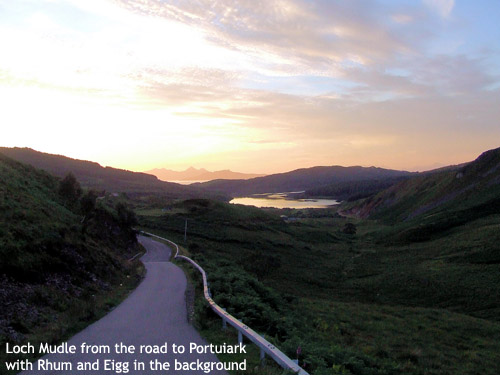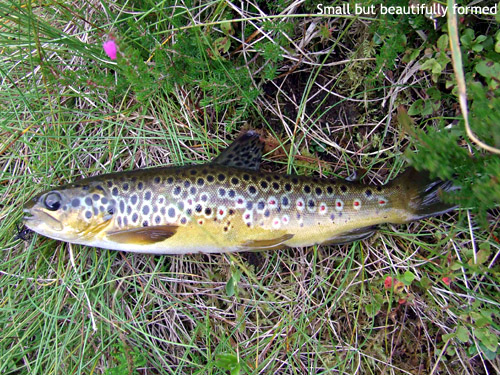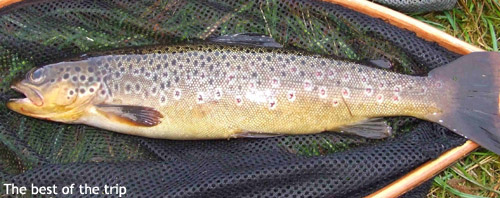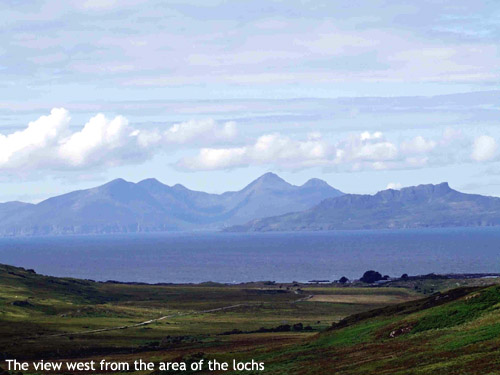Adventure in Ardnamurchan
- Details
- Published on Monday, 06 December 2010 17:53
- Written by Anthony Glasgow
 Freedom is a place called Ardnamurchan is a popular car sticker for those that know this 50-mile long peninsular that juts westward from Fort William into the Atlantic Ocean. Ardnamurchan Point is the western-most point on the British mainland and its famous lighthouse plays host to countless summer visitors every year. The famous beaches at Sanna also attract many loyal visitors who rejoice at the turquoise waters, magnificent views and clean sand. Between these two places lies a place called Portuairk – a place I have been
Freedom is a place called Ardnamurchan is a popular car sticker for those that know this 50-mile long peninsular that juts westward from Fort William into the Atlantic Ocean. Ardnamurchan Point is the western-most point on the British mainland and its famous lighthouse plays host to countless summer visitors every year. The famous beaches at Sanna also attract many loyal visitors who rejoice at the turquoise waters, magnificent views and clean sand. Between these two places lies a place called Portuairk – a place I have been
lucky to visit for the past 18 years.
This is a place of golden eagles, of sea eagles, of otters and of wildcats. This is also the place of my late father-in-law’s birth, and this is where my family holiday every summer. This is a place where children can still become feral, roam free over the rocks, swim in the sea and generally have what so many children are denied these days – freedom. Yes, freedom is a place called Ardnamurchan.
But not only does Ardnamurchan have beaches, islands and a spectacular coastline – it also has trout fishing. Not the wildest trout fishing you will ever have, nor are you likely to catch the fish of a lifetime, but it has trout fishing for eager wild brownies amidst wonderful scenery and peaceful solitude - and that’s enough for me.
The main loch at the western end of the peninsular is Loch Mudle and it is when I sight this loch from the single track road leading to Portuiark, with the islands of Eigg, Rhum and Skye in the background, that I feel I have arrived at my holiday destination. I can think of no better view of a loch than this, but I know that I am biased due to my affection for this area. Loch Mudle has browns aplenty plus sea-trout and the occasional salmon. There are also adders in the heather and deer on the hillside. Behind Mudle there are other, smaller lochs and it is these that normally get my attention as I eschew the more popular, easily accessible Mudle.
The fishing here is now run by the Ardnamurchan estate. However, a few years ago it was leased by Nick Peake who did much to try and gently improve the quality of sport on offer by improving habitat and spawning potential. Nick and I always tried to have a day together fishing the local lochs where we would delight in hitting feisty fish after fish. Alas, Nick relocated and was unable to continue with leasing, but the lochs remain in good fettle being only lightly fished.
The following is a tale of a visit to ‘the back lochs’ a few years ago with a salutary reminder to others of the perils of forgetting how time changes everything – from your own fitness to how much trees can grow in 15 years…
There are two ways of fishing ‘the back lochs’ – the easy way and ‘the other way’. The easy way is no doubt to ask the Estate for the keys to the gates on the forest path and to take your car as far as you can before doing relatively short walks through the pine plantations to the lochs. The easy way is still not easy at all, for traversing through the plantations from loch to loch is not straightforward and you are well advised to be able to use map, compass and GPS before you try. The ‘other way’ is to park your car by Loch Mudle (Grid NM 548 649 – OS Map Sheet 47) and travel a circuit by foot, taking in as many lochs as you can manage. The Estate office is in Kilchoan only minutes away so getting a permit is not difficult although at the time of this visit it was Nick I had permission from. This other way was relatively straightforward 15 years ago when the plantation was younger, as were my own legs…
The reason I chose the ‘other way’ on this trip was that relatively rare event in these parts – a south easterly wind. The prevailing wind is from the west, bringing with it the usual squalls from the Atlantic. In order to ‘go with the wind’ and use it to fish down the lochs as I went about my circular expedition, it made sense to fish ‘anti-clockwise’ – so the die was cast, shank’s pony it would be.
The first loch encountered on this route was Lochan a Mhadaidh Riabhaich. This is the loch I had fished on a regular basis, being less popular than Mudle but close enough for a quick walk from the road where you can be fishing within half an hour. My usual way of fishing this loch is to carry waders etc in a day sack and walk over the shoulder of Beinn Bhuidhe (thus avoiding the lower boggy ground that lies immediately between Mudle and Mhadaidh Riabhaich). I get to the loch, change into waders, ground-dump my rucksack and fish round the loch (clockwise or anticlockwise depending on the wind) and come back to pick  up my gear before scuttling back over the hill and home before my absence from the family becomes too noticeable. (On a slight digression, I know there is a body of opinion which dislikes wading in wild lochs, but I have found that without waders you are often otherwise soaked as you traverse bog and burn, and that you are unable to use the wind effectively and to cover all the water in the margins).
up my gear before scuttling back over the hill and home before my absence from the family becomes too noticeable. (On a slight digression, I know there is a body of opinion which dislikes wading in wild lochs, but I have found that without waders you are often otherwise soaked as you traverse bog and burn, and that you are unable to use the wind effectively and to cover all the water in the margins).
On this occasion however, I would only be passing the loch on my way to Lochan na Carraige. I had decided to make use of what I had surmised was a firebreak in the north-east of the surrounding plantation when I had last fished Mhadaidh Riabhaich to make easier progress to this loch I had only fished once before. The distance was only 1km on the map – surely not too difficult for an ex-Army man?
How wrong I was. 15 years of growth, and more importantly of trees blowing down in the frequent storms of these parts, rendered the route – after the first deceptively clear element that I had seen from the shore of Mhadaidh Riabhaich – almost impassable. There was no fire break, there was no continuous furrow to follow, there was just 1km of fallen trees and treacherous bog to negotiate. Thankful that I was travelling light, with my Hardy Smuggler #5 not yet set up (it would have ended up in far more than its normal 7 sections if it had been), I literally battled, crawled, climbed and slithered my way through the fallen trees following what were deer tracks through the tangle of timber until, at last, I appeared sweating profusely and caked in mud at the small lochan that was the satellite of Lochan na Carraige.
Having taken some time to cool off and to then put on my waders (a bit late given how wet I was), I at last got the chance to explore this enchanting lochan. At only 500m long and perhaps 100m wide, this was no large loch, but that’s the way I like it - an intimate experience for the lone angler to cast and step their way round a loch barely troubled by anglers throughout the year. Having taken note of the abundance of flying ants falling onto the loch, I armed myself with a cast comprising an Alexandra on the point, a russet palmer in the middle and a Bibio on the top dropper. This is almost my go-to-first cast in all wild lochs. The Alexandra is, I am sure, taken as a beetle imitation, the russet palmer is taken for a host of terrestrial insects (in this case I hoped a flying ant) and the Bibio is taken as a Heather Fly. In order to best exploit it as an ant imitation, my russet palmer was size 14 where the other flies stayed the usual size 12. Success was immediate and repeated – all on the wee russet palmer. All terrier-like and quick as lightning, these were not large fish but how they scrapped on my 5-weight rod. I have often wanted to scale down further to a 2 or 3 weight to really allow these ¼ - ½ lb fish to show what they are made of, but given the strength of the wind in most highland parts and the need to cast across the wind to work the flies to their best effect, I remain attached to my Hardy #5.
So with success and a feeling that the struggle had been worthwhile, I moved on to Lochan nan Sioman – a thankfully short 200m walk over rock and heather rather than through dense forest. My previous immediate success was not repeated, despite a similar fall of ants. A light rain started to fall and I took out my lightweight waterproof – no sense in getting wet and cold when at a remote loch – when I suddenly experienced shooting pain on my neck.  The pain seemed to spread and grow worse and I knew I had been bitten/stung by something, but of course could not see exactly where and by what, given the location of my discomfort. Thankfully I carry an ‘after-bite pen’ (as well as so many other things) in my fishing waistcoat and so I found myself applying the soothing solution all over my neck whilst considering the unlikely but not altogether ridiculous notion that were I to have any kind of anaphylactic reaction whilst at this remote spot I was, frankly, a goner. The likely culprit was of course a flying ant attack but my mind went through a range of possibilities such as an adder in the hood of my jacket. No melodrama here then…!
The pain seemed to spread and grow worse and I knew I had been bitten/stung by something, but of course could not see exactly where and by what, given the location of my discomfort. Thankfully I carry an ‘after-bite pen’ (as well as so many other things) in my fishing waistcoat and so I found myself applying the soothing solution all over my neck whilst considering the unlikely but not altogether ridiculous notion that were I to have any kind of anaphylactic reaction whilst at this remote spot I was, frankly, a goner. The likely culprit was of course a flying ant attack but my mind went through a range of possibilities such as an adder in the hood of my jacket. No melodrama here then…!
Having soothed the affected area, I continued to fish (well, if there was to be an anaphylactic reaction, I might as well keel over whilst playing a trout). By some twist of happy fate, I was shortly to connect with my best fish of the trip, a hard-pulling brown of comfortably over the pound which put a wonderful arc into my 8ft rod. Safely released to fight another day, I fished on to the north-west tip of the loch before setting my sights on another cross-country hike of a kilometre and a half to cast into Lochan Creag nan Dearcag. Had my initial walk been less arduous I would have also taken in Lochan Creag nan Con, but now time was against me. I had promised my kids to take my boat out into Sanna Bay later that day to check our creels for lobster and crab, and now I sensed that I was pushing my luck with the family.
While not as demanding as the initial walk, the traverse proved demanding enough (in particular having decided to keep on my waders and felt boots). Felt boots and grass certainly don’t mix and I had a couple of interesting tumbles which could easily have resulted in a badly damaged knee (again this would have been interesting in terms of extracting myself from within dense forest…). But time was pressing on and I didn’t want to waste precious fishing time getting in and out of waders.
 Sadly, my investment in time proved a poor one, as both Lochan nan Dearcag and Lochan na Tuaidh proved dour with only a few fish showing any interest. Perhaps it was the lightening of the wind, or the ending of the flying ants that caused the trout to go down, but perhaps it was just that I wasn’t fishing as hard, conscious that I had to keep moving even faster than I normally did when covering these wild lochs. Whatever the reason, my fishing came to a natural end as I headed from Lochan na Tuaidh to hit the end of the forest track whence I began a rapid walk back to the car. Arriving some 3hours late and having missed the tide to get the boat afloat to check our creels, my wife did enquire as to why I hadn’t turned back when she heard of the tough going. My reply was simply ‘that I had set out to go fishing, and that’s what I was going to do, no matter what’. Well, there’s no fool like an old fool.
Sadly, my investment in time proved a poor one, as both Lochan nan Dearcag and Lochan na Tuaidh proved dour with only a few fish showing any interest. Perhaps it was the lightening of the wind, or the ending of the flying ants that caused the trout to go down, but perhaps it was just that I wasn’t fishing as hard, conscious that I had to keep moving even faster than I normally did when covering these wild lochs. Whatever the reason, my fishing came to a natural end as I headed from Lochan na Tuaidh to hit the end of the forest track whence I began a rapid walk back to the car. Arriving some 3hours late and having missed the tide to get the boat afloat to check our creels, my wife did enquire as to why I hadn’t turned back when she heard of the tough going. My reply was simply ‘that I had set out to go fishing, and that’s what I was going to do, no matter what’. Well, there’s no fool like an old fool.
Anthony Glasgow is a lifelong and passionate fisherman, in particular for wild brown trout. Retired from the Royal Engineers as a major in 2004, aged 38 having served in UK, Germany, Canada, Northern Ireland, Bosnia and the Gulf. Now working in Perthshire (where good hillwalking and fishing is but minutes away – coincidence?). Despite his diminutive build, was once considered a good rugby player, but now fishing takes priority whenever he has the time!

